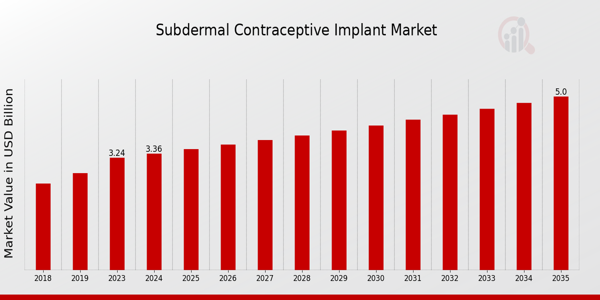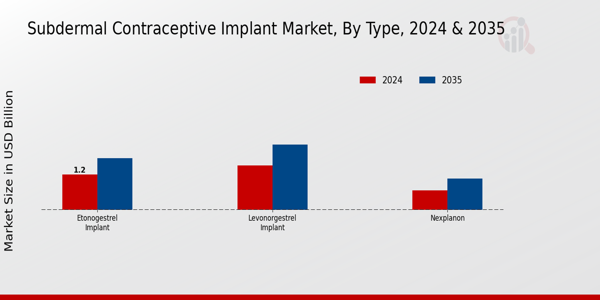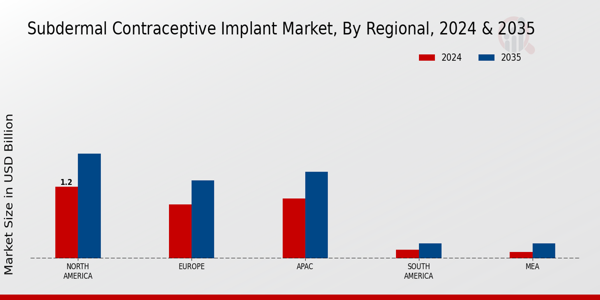Subdermal Contraceptive Implant Market Overview
As per MRFR analysis, the Subdermal Contraceptive Implant Market Size was estimated at 3.24 (USD Billion) in 2023.
The Subdermal Contraceptive Implant Market Industry is expected to grow from 3.36(USD Billion) in 2024 to 5.0 (USD Billion) by 2035. The Subdermal Contraceptive Implant Market CAGR (growth rate) is expected to be around 3.69% during the forecast period (2025 - 2035).
Key Subdermal Contraceptive Implant Market Trends Highlighted
The global market for subdermal contraceptive implants is heavily impacted by a number of important players. People are considering long-term contraceptive choices more frequently as a result of increased understanding of family planning and reproductive health. Reliable contraceptive methods are more important than ever because of the rising number of unwanted pregnancies. Subdermal implants are also a popular option for many women due to the development of more effective and user-friendly versions brought about by improvements in healthcare technology. Growing government and healthcare support for reproductive health efforts is another significant motivator.
In this market, there are numerous opportunities to seize. With the growing need for contraceptive choices, businesses can concentrate on introducing new and cutting-edge technology into their product lines. Creating implants with longer release profiles or fewer adverse effects could help them appeal to a wider range of users. Expanded partnerships between producers and healthcare providers can improve distribution networks and increase the accessibility of these products. Additionally, there is a market in underdeveloped nations where there are opportunities for growth as knowledge and awareness of contraceptive choices continue to rise.
Current trends show that healthcare is increasingly moving toward individualized solutions. Consumers are increasingly looking for contraceptive techniques that suit their unique health requirements and lifestyles. This pushes R&D in the direction of longer lasting and customizable solutions. Social media and digital health platforms are playing a crucial role in educating users about subdermal implants, leading to informed decision-making. With businesses investigating environmentally friendly production methods and packaging for these contraceptives, the trend toward sustainability is also evident. Overall, the market is evolving with a focus on innovation, education, and accessibility.

Source: Primary Research, Secondary Research, MRFR Database and Analyst Review
Subdermal Contraceptive Implant Market Drivers
Rising Demand for Long-Term Contraceptive Solutions
The Subdermal Contraceptive Implant Market Industry is experiencing a significant increase in demand for long-term contraceptive solutions. Many individuals are shifting towards these implants due to their effectiveness and convenience. Unlike traditional methods, such as oral contraceptives, which require daily attention, subdermal implants provide a hassle-free option that lasts for multiple years. This shift towards long-term solutions is largely influenced by the desire for better family planning and reproductive health management.
Moreover, there is a growing awareness about various contraceptive options available, aided by healthcare professionals and awareness campaigns. The advancements in technology have also led to improvements in the design and effectiveness of these implants, attracting a broader population base. As society continues to advocate for women's health and empowerment, the trend toward utilizing such permanent and reversible contraceptive methods is projected to solidify in the upcoming years.
The societal moves towards family planning and reproductive autonomy are major factors propelling the growth of the Subdermal Contraceptive Implant Market Industry, indicating a shift not only in consumer preferences but also in the implementation of healthcare policies that support reproductive choices.
Increased Awareness and Education on Reproductive Health
The expansion of educational initiatives and awareness programs regarding reproductive health has significantly influenced the Subdermal Contraceptive Implant Market Industry. Educational outreach by health organizations and NGOs plays a pivotal role in informing individuals about their contraceptive options, including the benefits of subdermal implants. Such initiatives emphasize the safety, efficacy, and convenience of these implants, helping to demystify misconceptions and leading to more informed choices.
As more people become educated about family planning and reproductive health, the demand for effective contraceptive methods increases.
Supportive Government Policies and Healthcare Initiatives
Government policies aimed at improving women's health and access to contraceptive options serve as major drivers for the Subdermal Contraceptive Implant Market Industry. Many governments are implementing policies that either subsidize or provide these implants for free to encourage their use. Such initiatives often aim at reducing unintended pregnancies and improving maternal health outcomes, thereby driving more individuals to seek subdermal implants as a viable option for family planning.
This supportive regulatory framework contributes positively to market growth.
Subdermal Contraceptive Implant Market Segment Insights
Subdermal Contraceptive Implant Market Type Insights
The Subdermal Contraceptive Implant Market is poised for steady growth, with a market valuation expected to reach 3.36 USD Billion by 2024 and further escalate to 5.0 USD Billion by 2035. A significant component of this market encompasses various types of implants, which play a crucial role in the overall contraceptive landscape. The Etonogestrel Implant is valued at 1.2 USD Billion in 2024 and is projected to grow to 1.75 USD Billion by 2035, making it an essential player in the market with its efficacy and prolonged effectiveness. This segment has garnered substantial attention due to its low maintenance requirements and high success rate in preventing unwanted pregnancies, thus driving substantial adoption among women seeking reliable contraceptive options.
The Levonorgestrel Implant stands as another significant type within the Subdermal Contraceptive Implant Market, starting at a valuation of 1.5 USD Billion in 2024 and expanding to 2.2 USD Billion by 2035. This implant has gained notable recognition for its ability to provide long-term pregnancy prevention with minimal side effects, contributing to its majority holding in the market. The strong demand for Levonorgestrel Implant can be attributed to its comprehensive clinical evidence and favorable patient compliance. Meanwhile, the Nexplanon type of implant, valued at 0.66 USD Billion in 2024, is expected to grow to 1.05 USD Billion by 2035.
Although it currently holds a smaller share compared to its counterparts, Nexplanon's innovative delivery system enhances user accessibility and offers significant advantages that appeal to a specific demographic; thus, it plays a vital role in expanding the market outreach. The Subdermal Contraceptive Implant Market shows promising potential, propelled by changing demographics, increasing awareness surrounding family planning, and a growing emphasis on women's health. The blend of these types within the market allows for varied contraceptive choices tailored to individual preferences, thus indicating a dynamic landscape poised for future developments.

Source: Primary Research, Secondary Research, MRFR Database and Analyst Review
Subdermal Contraceptive Implant Market Procedure Insights
The Subdermal Contraceptive Implant Market, focusing on the Procedure segment, is projected to gain substantial traction in the upcoming years. The market had a valuation of 3.36 billion USD in 2024 and is positioned for steady growth, leading to a target valuation of 5.0 billion USD by 2035. This segment encompasses essential processes, including Insertion Procedure, Removal Procedure, and Follow-Up Procedure, each critical to ensuring user satisfaction and efficacy of the implants. The Insertion Procedure plays a vital role as it initially establishes contraceptive efficacy, while the Removal Procedure also holds significant importance, addressing concerns related to device removal and patient comfort.
Additionally, the Follow-Up Procedure is crucial for monitoring, ensuring proper functioning, and addressing any potential complications. With growing awareness and acceptance of long-term contraceptive methods, the demand for these procedures is expected to rise, bolstered by favorable reproductive health policies and increasing healthcare access. However, challenges such as procedural costs and the need for skilled practitioners persist, creating opportunities for innovation and improved training programs in the Subdermal Contraceptive Implant Market.
Overall, this segment is pivotal as it directly influences patient experiences and outcomes in the broader contraceptive landscape.
Subdermal Contraceptive Implant Market End User Insights
The Subdermal Contraceptive Implant Market showcases a robust framework revolving around the End User segment, which plays a pivotal role in driving market dynamics. By 2024, the market is expected to reach a valuation of 3.36 billion USD, highlighting its growing importance in women's health. The landscape encompasses several key categories, notably Hospitals, Clinics, and Home Healthcare. Hospitals and clinics dominate this landscape due to their accessibility, advanced medical service infrastructure, and the trust they command among patients.
These facilities often provide comprehensive contraceptive services, which ensure proper guidance and support for the users. Meanwhile, Home Healthcare is gaining traction, driven by the increasing preference for convenience and personalized care, enabling patients to manage their contraceptive options outside traditional clinical settings. The Subdermal Contraceptive Implant Market revenue reflects changing societal attitudes toward contraceptive methods, alongside factors such as increasing awareness and education on reproductive health.
These trends present numerous opportunities for growth amidst various challenges, including regulatory hurdles and the need for innovative solutions to meet specific patient needs, making the market a dynamic area of interest for stakeholders.
Subdermal Contraceptive Implant Market Age Group Insights
The Subdermal Contraceptive Implant Market has shown significant interest in various age groups, reflecting distinct preferences and needs. By 2024, this market is set to reach a value of 3.36 billion USD, highlighting the growing acceptance of long-term contraceptive solutions among different demographics. Among these, adolescents represent a vital segment as awareness and access to reproductive health resources continue to rise, leading to increased adoption of subdermal implants. Adults typically dominate the usage due to their elevated contraceptive needs and understanding of long-term family planning options.
Meanwhile, older adults, often seeking alternatives to traditional methods, leverage this technology for its convenience and effectiveness. The market growth is further supported by factors such as increasing awareness about reproductive health, a push for effective birth control methods, and the rising acceptance of long-acting reversible contraceptives (LARCs). Nevertheless, challenges remain, including cultural misconceptions and healthcare accessibility, which could impact the market's expansion. The capacity to cater to the unique demands of these age groups will present significant opportunities within the Subdermal Contraceptive Implant Market industry, ensuring that a holistic range of services and products are provided.
Overall, the segmentation of age groups within this market reflects its comprehensive nature and the need for targeted approaches in addressing reproductive health needs.
Subdermal Contraceptive Implant Market Regional Insights
The Subdermal Contraceptive Implant Market revenue reflects significant regional variations. In 2024, North America holds a majority stake with a valuation of 1.2 USD Billion, anticipated to grow to 1.75 USD Billion by 2035, driven by increasing awareness of reproductive health and access to contraceptive options. Europe, valued at 0.9 USD Billion in 2024 and expected to reach 1.3 USD Billion by 2035, showcases a strong market due to progressive policies and healthcare infrastructure. The APAC region, with a market value of 1.0 USD Billion in 2024, is projected to grow to 1.45 USD Billion by 2035, fueled by rising population concerns and urbanization.
South America stands at 0.15 USD Billion in 2024, increasing to 0.25 USD Billion by 2035, reflecting a gradually expanding market driven by improving healthcare access. Meanwhile, the MEA region, currently valued at 0.11 USD Billion in 2024 and expected to grow to 0.25 USD Billion by 2035, shows potential due to increasing healthcare initiatives despite facing challenges related to cultural perceptions. The growth drivers across these regions indicate a strong demand for effective contraceptive solutions, creating ample opportunities within the Subdermal Contraceptive Implant Market industry.

Source: Primary Research, Secondary Research, MRFR Database and Analyst Review
Subdermal Contraceptive Implant Market Key Players and Competitive Insights
The Subdermal Contraceptive Implant Market is a rapidly evolving sector within the contraceptive landscape, characterized by its innovative approaches toward reproductive health. With an increasing global focus on family planning and empowered reproductive choices, various entities in the market are competing to provide effective long-term contraceptive solutions. The market dynamics are shaped by regulatory developments, technological advancements, and shifts in consumer preferences. This creates fertile ground for intense competition among companies striving to establish their foothold, offering diverse subdermal contraceptive products that cater to different demographics. With rising awareness of the advantages of hormonal contraceptives, including their discreet nature and reduced need for daily attention, a competitive environment has engendered ongoing research and development, leading to new product launches and strategic partnerships aimed at increasing market penetration.
HRA Pharma has distinguished itself in the Subdermal Contraceptive Implant Market through its innovative and patient-centered approach. The company's strong emphasis on research and development has allowed it to bring to market products that are not only effective in preventing pregnancy but also cater to the evolving needs of women around the world. With a robust selection of implantable contraceptives, HRA Pharma has built a strong reputation for quality and reliability. The organization benefits from a well-established distribution network that facilitates access to its products in diverse regions, thereby enhancing its market presence. Additionally, HRA Pharma's commitment to education and the promotion of reproductive health initiatives underscores its position as a trusted leader in the market, appealing to both healthcare providers and patients seeking reliable contraceptive choices.
Ferring Pharmaceuticals has carved out a notable position in the Subdermal Contraceptive Implant Market by focusing on developing effective, long-term contraceptive options that meet the specific needs of users. The company leverages its extensive expertise in reproductive medicine to create products that not only provide reliable contraception but also improve the overall user experience. Ferring Pharmaceuticals is recognized for its commitment to research and innovation, continually striving to enhance the safety and efficacy of its offerings. Their strong global presence enables them to maintain a competitive edge, ensuring that the company's subdermal implants are accessible to a broad audience. Additionally, Ferring Pharmaceuticals frequently engages in collaborations and strategic partnerships aimed at advancing reproductive health solutions, further solidifying their influence within the market and fostering loyal relationships with healthcare professionals and patients alike.
Key Companies in the Subdermal Contraceptive Implant Market Include
- HRA Pharma
- Ferring Pharmaceuticals
- Watson Pharmaceuticals
- Daiichi Sankyo
- Merck
- Teva Pharmaceutical Industries
- HoffmannLa Roche
- BristolMyers Squibb
- Pfizer
- Eton Pharmaceuticals
- Intas Pharmaceuticals
- Mylan
- Bayer
- Gedeon Richter
Subdermal Contraceptive Implant Market Industry Developments
Recent developments in the Subdermal Contraceptive Implant Market indicate heightened activities among key players such as HRA Pharma, Merck, and Bayer, reflecting a growing emphasis on innovative contraceptive solutions. Ferring Pharmaceuticals and Teva Pharmaceutical Industries have also been noted for their advancements in product offerings and market expansion strategies to cater to increasing demand. Notably, the market has experienced significant growth in overall valuation, largely due to heightened awareness around reproductive health and family planning, which has contributed to an uptick in usage among women globally. Furthermore, there have been some notable mergers and acquisitions within the sector; for example, discussions around potential collaborations among major organizations are ongoing, although specific deals are yet to be publicly confirmed. Eton Pharmaceuticals and Mylan have been mentioned due to their expanding portfolios aimed at improving contraceptive access. These dynamics underscore a competitive landscape, fostering innovation while addressing challenges such as accessibility and affordability, which ultimately impact market growth potential. The increasing focus on women's health issues is likely to enhance the role of companies like Gedeon Richter and HoffmannLa Roche in shaping future market directions.
Subdermal Contraceptive Implant Market Segmentation Insights
Subdermal Contraceptive Implant Market Type Outlook
- Etonogestrel Implant
- Levonorgestrel Implant
- Nexplanon
Subdermal Contraceptive Implant Market Procedure Outlook
- Insertion Procedure
- Removal Procedure
- Follow-Up Procedure
Subdermal Contraceptive Implant Market End User Outlook
- Hospitals
- Clinics
- Home Healthcare
Subdermal Contraceptive Implant Market Age Group Outlook
- Adolescents
- Adults
- Older Adults
Subdermal Contraceptive Implant Market Regional Outlook
- North America
- Europe
- South America
- Asia Pacific
- Middle East and Africa
| Attribute/Metric Source: |
Details |
| MARKET SIZE 2023 |
3.24(USD Billion) |
| MARKET SIZE 2024 |
3.36(USD Billion) |
| MARKET SIZE 2035 |
5.0(USD Billion) |
| COMPOUND ANNUAL GROWTH RATE (CAGR) |
3.69% (2025 - 2035) |
| REPORT COVERAGE |
Revenue Forecast, Competitive Landscape, Growth Factors, and Trends |
| BASE YEAR |
2024 |
| MARKET FORECAST PERIOD |
2025 - 2035 |
| HISTORICAL DATA |
2019 - 2024 |
| MARKET FORECAST UNITS |
USD Billion |
| KEY COMPANIES PROFILED |
HRA Pharma, Ferring Pharmaceuticals, Watson Pharmaceuticals, Daiichi Sankyo, Merck, Teva Pharmaceutical Industries, HoffmannLa Roche, BristolMyers Squibb, Pfizer, Eton Pharmaceuticals, Intas Pharmaceuticals, Mylan, Bayer, Gedeon Richter |
| SEGMENTS COVERED |
Type, Procedure, End User, Age Group, Regional |
| KEY MARKET OPPORTUNITIES |
Increasing demand for long-term contraceptives, Rising awareness about family planning, Growth in women's healthcare initiatives, Technological advancements in implant design, Expanding distribution channels in developing regions |
| KEY MARKET DYNAMICS |
Increasing demand for long-term contraception, Rising awareness of reproductive health, Technological advancements in implant design, Growing acceptance in developing regions, Government initiatives supporting family planning |
| COUNTRIES COVERED |
North America, Europe, APAC, South America, MEA |
Frequently Asked Questions (FAQ) :
The Subdermal Contraceptive Implant Market is expected to be valued at 3.36 billion USD in 2024.
By 2035, the Subdermal Contraceptive Implant Market is projected to reach a value of 5.0 billion USD.
The expected CAGR for the Subdermal Contraceptive Implant Market from 2025 to 2035 is 3.69%.
North America is expected to dominate the Subdermal Contraceptive Implant Market with a value of 1.2 billion USD in 2024.
The Levonorgestrel Implant segment is projected to reach a market size of 2.2 billion USD in 2035.
Major players in the Subdermal Contraceptive Implant Market include HRA Pharma, Merck, Pfizer, and Bayer.
The Etonogestrel Implant segment is estimated to be valued at 1.2 billion USD in 2024.
The South American market for Subdermal Contraceptive Implants is expected to grow to 0.25 billion USD by 2035.
In 2024, the Nexplanon segment is expected to be valued at 0.66 billion USD.
Emerging trends in the Subdermal Contraceptive Implant Market include increasing adoption due to convenience and rising awareness regarding reproductive health.

















